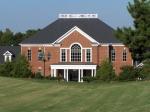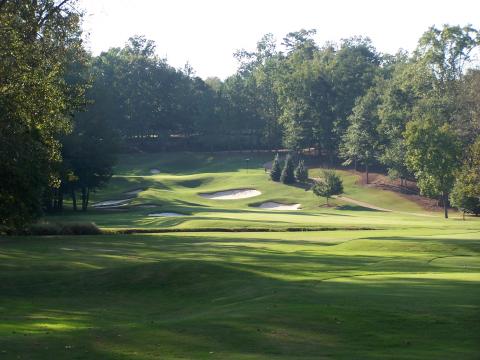A few years ago, I reviewed the Thornblade Club, the home course of new U.S. Open champion Lucas Glover (see yesterday's article below). I published the review in the original Home On The Course newsletter and included reviews of other golf communities on the south end of Myrtle Beach's Grand Strand as well as the three top communities in Aiken, SC. If you would like a copy of that newsletter emailed to you, send me your email address by clicking here and I will forward it to you.
Some of us may not want to spend our retirement days in an "organized" golf development where we pay extra for amenities we do not want. We are content to join a private club with a fabulous golf course and purchase a house nearby that has quick and easy access to all the things we want in a community. Thornblade, since 1987 one of the Greenville, SC, area's finest country clubs, provides an excellent reason to customize your golf-oriented-living situation.
The Thornblade Club is actually located in Greer, just 15 miles from Greenville and less than that to the Greenville/Spartanburg Airport. The club is intimate with the surrounding community of mostly brick houses on mostly small lots, which is a gentle way of saying the homes are in view and occasionally just out of play. The Thornblade course might feel claustrophobic to some, but we found that windows and roofs are substantially out of harm's way.

The par 3 11th at Thornblade is an all or nothing-at-all affair.
All homes available in the Thornblade community are re-sales, and the most upscale -- those abutting the golf course with ¾ acre and larger lots --exceed $1 million, but not by much. Champions Tour player Jay Haas lives in one of those. There are some three-story townhouses with golf course views available in the mid-six figures, and nice single-family homes on small lots for about the same. Many of Thornblade's members own houses in the neighborhood and can walk (or ride a cart) to the club. [Editor's Note: Although this article was written in 2006, prices today have receded to about the levels at the time of this review.]
with golf course views available in the mid-six figures, and nice single-family homes on small lots for about the same. Many of Thornblade's members own houses in the neighborhood and can walk (or ride a cart) to the club. [Editor's Note: Although this article was written in 2006, prices today have receded to about the levels at the time of this review.]
The golf course is a classic mid-1980s design by Tom Fazio, with all the distinctive Fazio features we have come to love, including the funneled fairways, large multi-shape bunkers and amply sized, challenging green complexes. Built on 130 acres, the course appears to have been constructed after the houses were in place. Yet Fazio has created an unfussy design, tucking away the cart paths through the woods and behind mounding. It is a clean, sleek track, but by no means easy. The "Thornblade" tees play to a mild 6,300 yards but carry a rating of 71.6 and a chesty slope of 137.
For the low handicap player, distance from the Haas tees, named in honor of their noted member, is 6,700 yards with a slope of 143. Still, we saw many women on the course, enjoying the routing from the "Rose" tees at 5,000 yards. The club emphasizes active ladies and junior golf programs, as well as the customary men's golfing get togethers. If you are looking for organized golfing activities, you'll find them at Thornblade, which also offers such customary country club amenities as a large swimming pool complex and a tennis center with 11 lighted courts, seven of them Har-Tru. The clubhouse is large and well appointed, and judging from one Wednesday night buffet, the food variety and quality is at the high end. (We couldn't help but notice a choice of more than five main dishes and a dozen desserts on the buffet.) This is a family-oriented golf club, and if you are looking for the company of adults only, look elsewhere. But if you want the extra vibrancy of a country club atmosphere that includes young members, Thornblade is worth a look.
programs, as well as the customary men's golfing get togethers. If you are looking for organized golfing activities, you'll find them at Thornblade, which also offers such customary country club amenities as a large swimming pool complex and a tennis center with 11 lighted courts, seven of them Har-Tru. The clubhouse is large and well appointed, and judging from one Wednesday night buffet, the food variety and quality is at the high end. (We couldn't help but notice a choice of more than five main dishes and a dozen desserts on the buffet.) This is a family-oriented golf club, and if you are looking for the company of adults only, look elsewhere. But if you want the extra vibrancy of a country club atmosphere that includes young members, Thornblade is worth a look.
As you might expect, membership fees are much more reasonable than at golf-oriented developments that provide more amenities and multiple golf course choices. Full golf initiation for an equity membership at Thornblade is $29,000, $20,000 for non-equity, and dues are $395 per month. [Editor's Note: Dues have been reduced by about $2,000 in each category.] There are other levels of social memberships available at lower initiation fees and dues.
Bottom Line: Okay, so you'll have to work with a real estate agent and you'll have to settle for a nice house with "only" a golf course view (no breathtaking mountain views here). But the Fazio course is the equal of any in the Greenville area, and you will be able to walk from home to the clubhouse (and your neighbor's house). Initiation fees are $125,000 lower than at the nearby Cliffs Communities, but Thornblade has just one terrific 18-hole layout as opposed to The Cliffs' seven.

Thornblade compensates for its relative lack of length, in modern terms, with an abundance of strategically placed and quintessentially Fazio-shaped bunkers. From the tips, the course plays to just 6,700 yards.
























